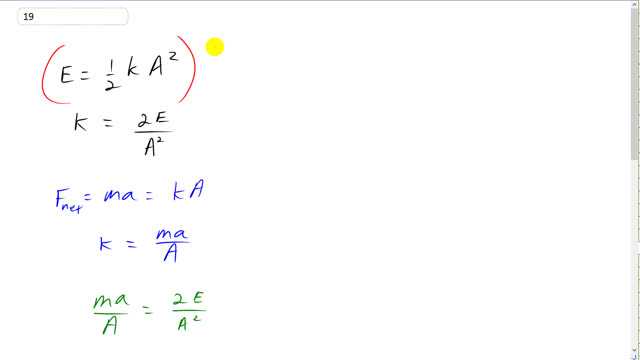
A mass resting on a horizontal, frictionless surface is attached to one end of a spring; the other end is fixed to a wall. It takes 3.6 J of work to compress the spring by 0.13 m. If the spring is compressed, and the mass is released from rest, it experiences a maximum acceleration of . Find the value of
- the spring constant and
- the mass.

In order to watch this solution you need to have a subscription.
This is Giancoli Answers with Mr. Dychko. We know the total energy is 1/2 times spring constant times amplitude squared. And we can solve this for k and say that it's 2 E over A squared multiplying both sides by 2 and dividing both sides by A squared and then switching the sides around. And we get k is 2E over A squared. We also know that when the spring is fully compressed, the net force that the block experiences will be ma because that's Newton’s second law. But we also know that the net force will also be the spring force because that's the only horizontal force that will be acting after the, you know, initially compressing force is removed, the only force that exists is the spring pushing back. And so ma equals k times the amount of the spring is compressed which is going to be equal to the amplitude since it's compressed maximally here. And so we solve for k by dividing both sides by amplitude. And k is mass and acceleration divided by amplitude. So, each of these things equals k, so that means they're equal to each other. So, ma over amplitude equals 2 times total energy divided by amplitude squared. And we can solve for m and multiply both sides by A and divide both sides by acceleration. And one of these A's cancels on the bottom and you have 2 E over amplitude times acceleration. So, I'm answering part B first as it turns out just the way my algebra worked. So, we have 2 times 3.6 joules divided by 0.13 meters amplitude times 12 meters per second squared acceleration which gives 4.6 kilograms. And then we have an equation for spring constant, mass times acceleration over amplitude. And now that we know mass we can substitute into that, 4.6154 kilograms times 12 meters per second squared divided by 0.13 meters gives about 430 newtons per meter for the spring constant.
For part a) it is asking for the amplitude of the motion. The video solved for the wrong question and the answer is also wrong.
Hi chaegyunkang, from your other questions it's clear that you're using the Global 7th Edition. I think this particular question was removed from the Global Edition.
All the best,
Mr. Dychko